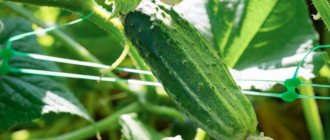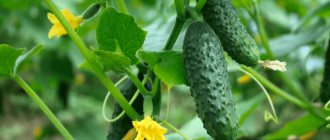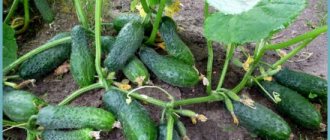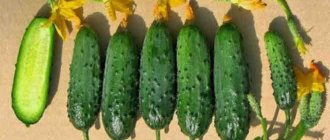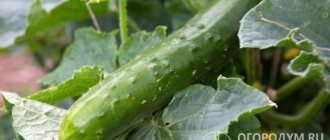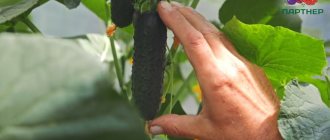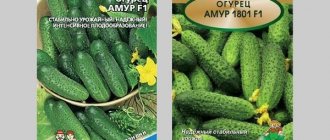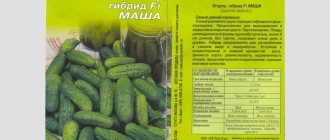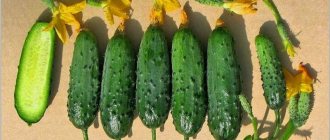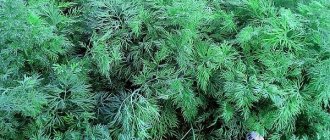» Vegetable growing » Cucumbers » Cucumber variety Alligator
0
1349
Article rating
Alligator cucumber is a hybrid of the f1 generation of Chinese selection. It is popular due to its interesting appearance, excellent taste and high yield. The variety is early ripening, bears fruit for a long time and rarely gets sick. Growing it is not particularly difficult, but it has its own nuances.
- Landing
- Care
- Pest Control
- Reviews
Alligator cucumber variety
Description of the Alligator variety
Alligator cucumbers are an early ripening hybrid. The ripening of the crop can be observed 46-49 days after emergence. The bushes are indeterminate, powerful, and grow quickly. The root system is well developed, thanks to which the bushes can withstand drought. The leaves are medium in size and have a pleasant green color. The petioles are small, with fluff. Up to 2 fruits can be formed in the internodes. Flowering is observed 3 weeks after emergence. The buds are large and yellow.
Flowering is observed 3 weeks after emergence
Interesting!
The Alligator cucumber is suitable for growing in the Central Black Earth, Volga-Vyatka, North-Western, Middle Volga, Northern, North Caucasus regions.
Cucumbers have an elongated, cylindrical shape and can be significantly narrowed in the area of the stalk. The length of the greens is 35-40 cm, weight – 280-310 g. The color is dark green, rich. The skin has visible, rather large tubercles on which spines are located. The peel is shiny, thin, not bitter and easy to eat. The flesh is dense and crispy. The seeds are small, long, and practically unnoticeable when eaten.
Description and characteristics of the variety
Alligator "Sedek" cucumbers have an extremely original appearance.
Their fruits can be called record holders in length, it can reach 35-45 cm. At the same time, they are quite thin in girth, so the average weight of an Alligator is about 300 g. The skin is decorated with moderately pronounced tubercles. The plant is medium-branched, powerful, tall, indeterminate. The length of the main lash can grow up to two and a half meters. The type of ovaries is bunched. The leaves are pentagonal in shape and slightly fluffy. Flowering type: female. The shoots weave well along horizontal supports.
Some gardeners mistake this hybrid for a Chinese alligator cucumber. It should not be confused: the Russian Alligator has the prefix f1, which denotes hybrid origin, so the properties of the plants are different.
The seeds inside the fruit are slightly elongated and medium in size. But they are not suitable for planting, since hybrid vegetables do not produce seeds suitable for cultivation.
The pulp of the fruit is aromatic, with a noticeable cucumber flavor and light sweetness, without bitterness. They are suitable for salads, but for winter preparations you will have to cut them into pieces or use only the shortest ones to fit in the jar.
Characteristics of cucumbers Alligator F1
Also check out these articles
- In what cases can you go nowhere without a chainsaw: situations on the farm and on the farm
- Gooseberry diseases
- Percheron horse breed
- Garlic variety Dobrynya
In gardening, the Alligator F1 cucumber is in great demand. To understand why this hybrid is so attractive, it is necessary to study its characteristics.
- The hybrid requires pollination by bees, so it is rarely chosen for greenhouse cultivation.
- There is a stable immunity to true and downy mildew, cucumber mosaic.
- The bushes are not afraid of short-term and return frosts and drought.
- Productivity per square of plantings is 14-16 kg.
Productivity per square of plantings 14-16 kg
- Fruiting is extended.
- The commercial quality is high, the fruits are suitable for long-term transportation.
- The fruits are valued for their juiciness, sweet taste and aroma.
Important!
The yield of a hybrid can be affected by weather disasters (strong wind, low temperatures, lack of sunlight, etc.), and not just care, site and soil.
Sowing Alligator cucumbers with seeds
You can choose a sunny or partially shaded place to grow the crop. The groundwater level should be low, and the soil should be fertilized and loose. As a fertilizer, you can take minerals (superphosphate, urea) or organic matter, such as humus, compost, wood ash.
The groundwater level should be low, and the soil should be fertilized and loose
Sowing seeds in open ground or a greenhouse is usually carried out in May or June. In the evening, the seeds should be soaked in a weak solution of potassium permanganate. The beds for sowing seeds are dug up, fertilized and watered. The holes are made at a distance of 50 cm and with a row spacing of 50-70 cm. The depth of seeding is 3-4 cm. Seeds germinate in open ground or a greenhouse at a temperature of +20...+25 degrees.
Landing rules
Cucumbers of the Alligator f1 variety love to grow in a sunny place. The roots of the plant do not tolerate large amounts of moisture, so you need to make sure that there is no groundwater or that the plant is growing in a hole - after each rain, the water will remain in the hole for a long time, thereby harming the cucumber plant.
Seeds can only be planted in warm soil. If the soil is cold, you need to bring it indoors and let it warm up for a day. For planting, it is preferable to use loose and light soil so that air has access to the roots.
There is no need to rush into planting - seeds should be planted only when the soil warms up to 12 degrees and the likelihood of night frosts disappears.
You need to leave a distance of about half a meter between the plants, and then the cucumbers will not cling to each other, which will allow them to be completely saturated with oxygen.
The seeds must be pre-treated - soaked in a solution of potassium permanganate. For 100 ml of water you will need one teaspoon (without a slide) of powder. Immerse the seeds in this solution and leave them there for 2-3 hours, and then place them on a towel, allowing them to dry completely. After which you can begin planting.
How to plant cucumber seedlings correctly
We recommend reading our other articles
- Indian Runner Duck
- Cherry Revna
- Varieties of zucchini for open ground
- How to feed peonies in spring?
You can also grow Alligator cucumbers using the seedling method to get an earlier harvest. Sowing seeds for seedlings is done in April-May. The seeds are sown in separate pots, because young shoots cannot tolerate picking. As they grow, seedlings need to be watered on time and provided with sufficient lighting. Feeding can be done, but is not necessary. This is usually done to prevent the seedlings from overgrowing or if there are clear signs of mineral deficiency.
Transplantation of seedlings into open ground occurs in May-June
Transplanting seedlings into open ground occurs in May-June, when warm weather sets in. In order for the seedlings to grow faster, it is best to start hardening 1-2 weeks in advance. By the time of transplanting into the ground, the sprouts should already have 2-3 true leaves. The distance between seedlings is maintained at 50-70 cm so that the cucumbers have room to grow and develop.
Important!
Alligator cucumbers consume a lot of nutrients from the ground, so it is recommended to fertilize the crop as it grows and autumn fertilize the soil after growing this hybrid.
How to grow your own
Alligator cucumbers can be grown using seedlings and seeds.
Planting by seedlings and seeds
It is recommended to warm the seeds in advance; for this, the material is kept for 30 days near heat sources, where the temperature does not drop below +25°C.
Before planting, it is worth disinfecting the seed material. Garlic mixture is especially effective in this regard. To prepare it, add 30 g of garlic to 100 g of water, mix everything, and add the seeds. Keep for 60 minutes. Take it out, wash it with water and place it on a damp cloth and leave it for two days.
Then the seeds are placed in the refrigerator for 24 hours.
It is recommended to plant cucumbers in prepared containers in April. It is best to prepare the soil in advance by taking sawdust, peat and humus in equal parts. For every 10 kg of this mixture, add two tablespoons of nitrophoska.
Fill the containers with prepared soil and place the seeds without deepening them too deeply. Water the soil with a spray bottle. The seedlings will be ready for planting in the ground in a month.
Some summer residents do not grow cucumbers using seedlings, but sow the seeds directly into the ground. It is worth doing this no earlier than mid-May so that the soil has time to warm up. To begin with, the seeds are soaked in potassium permanganate, then dried.
Small holes are made in the ground, where 2-3 seeds are placed. Then, when sprouts appear, it is necessary to remove weak shoots. The depth of planting seeds should not exceed 3-4 cm, the holes are located at a distance of at least half a meter.
Step-by-step cultivation and care
The most important thing in care is watering with warm water. The bushes are watered twice a week, the leaves are periodically irrigated with clean water. Feed twice a season, this will significantly increase the yield.
The vines of cucumbers grow strongly and curl; it is best to attach them to strong trellises.
Features of cultivation and possible difficulties
Growing Alligator cucumbers has its own characteristics:
- The plant must grow upward, so it needs good, stable support, otherwise the fruits will be deformed into unsightly hooks.
- The hybrid needs frequent watering and regular feeding.
As the plant grows, the leaves may turn yellow or develop powdery mildew. To prevent this from happening, the seedlings are covered at night, and potassium is added to the fertilizing.
Typical diseases and pests
Powdery mildew most often appears on the leaves of the plant, less often on the fruits themselves. After infection, several vines may fall off the bushes. Such a plant begins to slowly die, and if it grows, the fruits will be of low quality and in small quantities.
To prevent the disease, high humidity, frequent temperature changes, and weeds should not be allowed.
If the disease peronosporosis (downy mildew) is not noticed in time and the plants are not helped, entire fields may die. Yellow-green spots covered with a light green coating appear on the leaves. They attack the upper part of the leaf and quickly spread to other plants.
Downy mildew spreads due to high humidity and watering with cold water. It affects cucumbers quickly, since even the wind can spread the disease to other cucumbers.
White rot covers the entire plant, covering it with white bloom and so-called mucus. It spreads especially quickly in greenhouses, since there is high air humidity and many closely planted plants.
Slugs most often crawl out in the dark, when the pulp of cucumbers can be eaten without obstacles, causing the fruits to become unsuitable for food and the quality of the harvest decreases.
➣ Alligator cucumbers. Dimensions in kind. Greenhouse and open ground
Watch this video on YouTube
Caring for Alligator cucumbers
The hybrid is unpretentious and can be grown even in unfavorable conditions.
- The Alligator cucumber can be grown on a trellis or simply let it trail along the ground. But in the case of trellis growing, supports are made immediately after planting the seedlings, because the crop develops quickly.
- Watering is carried out once every 2-3 days, and during drought, in the summer, you can add water to the roots every day. This procedure is carried out in the early morning or evening, when the sun is setting. The water should be warm, preferably settled.
- Weeding is done after each watering or rain so that the soil does not form a dense crust. While weeding, it is also necessary to remove all weeds to keep the area clean.
In the case of trellis growing, supports are made immediately after planting the seedlings
Important!
When weeding, you should be careful not to touch the stems or roots of plants.
- Fertilizers are applied 3 times per season. The first feeding is done 2-3 weeks after emergence or planting of seedlings. At this time, a urea solution (15-20 g/1 l of water) is added so that the plants can grow green mass. When the first buds appear, spray with superphosphate (25-30 g/bucket of water). The third feeding is done when the first cucumbers appear. At this time, you can add the NPK complex.
- Yield rationing is usually not required. Alligator cucumbers produce a harvest commensurate with their strength, so there is no point in picking very small fruits or ovaries so that most of the crop can fully ripen.
Selection of seedlings
The right choice of seedlings is the key to a good harvest. There is a pattern: the warmer the climate, the older the seedlings should be. The younger the plant, the longer you will wait for fruits, but the easier it adapts to the soil and climate, the better it takes root
When choosing seedlings, pay attention to the following points:
Roots. For plants sold in cassettes (without a pot), the roots should be clearly visible. But for potted cucumbers, a protruding root system is not always good. Assess the condition of the roots. White, young sprouts quickly take root when planted. However, if you see dried, rotten, old or torn roots, be prepared for the fact that the plant simply will not survive. The complete absence of roots should also be alarming - cucumbers have a fairly developed root system with normal development.
Pot
Pay attention to its size. The older the seedling, the larger the capacity should be, and vice versa.
Parasites. Naturally, it is necessary to inspect the plant for pests. In particular, special attention should be paid to the back of the leaf - the favorite place of many insects. A bad sign is deformed leaves (viruses), cobwebs on the leaves (spider mites), black small insects on the stems (aphids), eggs on the leaves (other parasites).
Growing conditions. If the seedlings were germinated incorrectly, this will affect the viability of the plant and the harvest in the future. Light small leaves, a sparse tall bush, limp and fallen leaves are signs of a violation of the lighting and watering regime, and possible freezing. A dark stem at the base appears as a result of excessive watering and rotting of the root system. But curved and curled leaves of bright green color are a sure sign of growing the plant in turbo mode and overfeeding it with nitrogen fertilizers. Such plants may not bear fruit at all.
We recommend that you familiarize yourself with other varieties of hybrid cucumbers: “Herman”, “Aquarius”, “April”, “Merengue”, “Real Colonel”, “Hector F1”, “Shosha”.
When choosing seedlings, try to choose plants with minimal differences in “age”. By planting so-called peers, you will simplify the process of care for yourself, and also ensure the simultaneous appearance of the harvest. It would be useful to clarify whether hardened seedlings are for sale. This is not a necessary factor, but plants prepared in this way are more resistant to bad weather and produce more yield.
Diseases and pests on cucumbers
Pests and diseases appear on Alligator bushes usually due to improper care. To strengthen the immunity of cucumbers and destroy some diseases (if any have already appeared), you can use a fungicide such as Trichodermin. A good alternative may be the drugs Strobi, Alyette, Previkur, Infinito, Hom and the like.
Diseases and pests of Alligator cucumbers
Important!
Very often, the cause of diseases or pests on cucumbers is weeds growing on the site.
Cucumber Alligator F1 suffers more from pests than diseases. Nematodes, spider mites, and aphids are the most common guests of bushes. If a small number of pests appear, you can use soapy water for treatment. But if pests quickly spread throughout the area, it is worth using Bordeaux mixture. Among the strong insecticides that can destroy intrusive pests in a short time, you can choose Aktara, Inta-Vir, Actellik, Antiklesch, Metaldehyde.
Harvesting and processing of cucumbers
Harvesting occurs in July-August. During this time, most of the greens are collected. In the fall, only a few of the most resistant bushes remain, which continue to produce a little fruit. Cucumbers are collected as they ripen. It is not worth keeping greens on the plant, because over time they become tougher and lose their taste.
The Alligator cucumber is most often used just for fresh eating.
The Alligator cucumber is most often used simply for fresh eating. They are good in appetizers and salads. They can also be taken for preservation and pickling, but for convenience they are crushed or cut into large slices.
Reviews from gardeners about cucumbers of the Alligator F1 variety
The opinions of gardeners about Alligator F1 cucumbers are presented below.
- Marina Topoleva : “The Alligator F1 cucumber is indispensable for salads and summer snacks of any kind. They are most delicious when fresh, but I didn’t like them in jars. Their aroma is very pleasant, the flesh is incredibly juicy and sweetish. I grow them every year, but the harvest is not always large, perhaps due to a lack of minerals in the soil. Can grow in shaded areas, very hardy. I am completely satisfied with this hybrid – it justifies the planting.”
- Andrey Luchinov : “Among all the cucumber hybrids that I tried to grow on the plot, only Alligator F1 captivated me. In comparison with other species, it has many of the qualities that I value above all, namely: productivity, aroma, sweetish taste. These cucumbers are never bitter, crisp, dark green in color, so they are clearly visible on the bushes among the foliage. I recommend it to both experienced gardeners and beginners - they are easy to grow.”
- Diana Voinik : “Previously, we planted cucumbers only in greenhouses, but now we use exclusively open ground for this, and therefore the varieties have changed. One of my favorites is Alligator. It is not troublesome to care for, produces a decent harvest, and has decent taste. True, it also has a drawback - the fruits are prickly. After ripening, they are covered with small but visible thorns, which my husband simply wipes with his hands, but my daughter and I have to use a cloth for these purposes. This makes collecting greens a real hassle, but they are worth the effort!”
